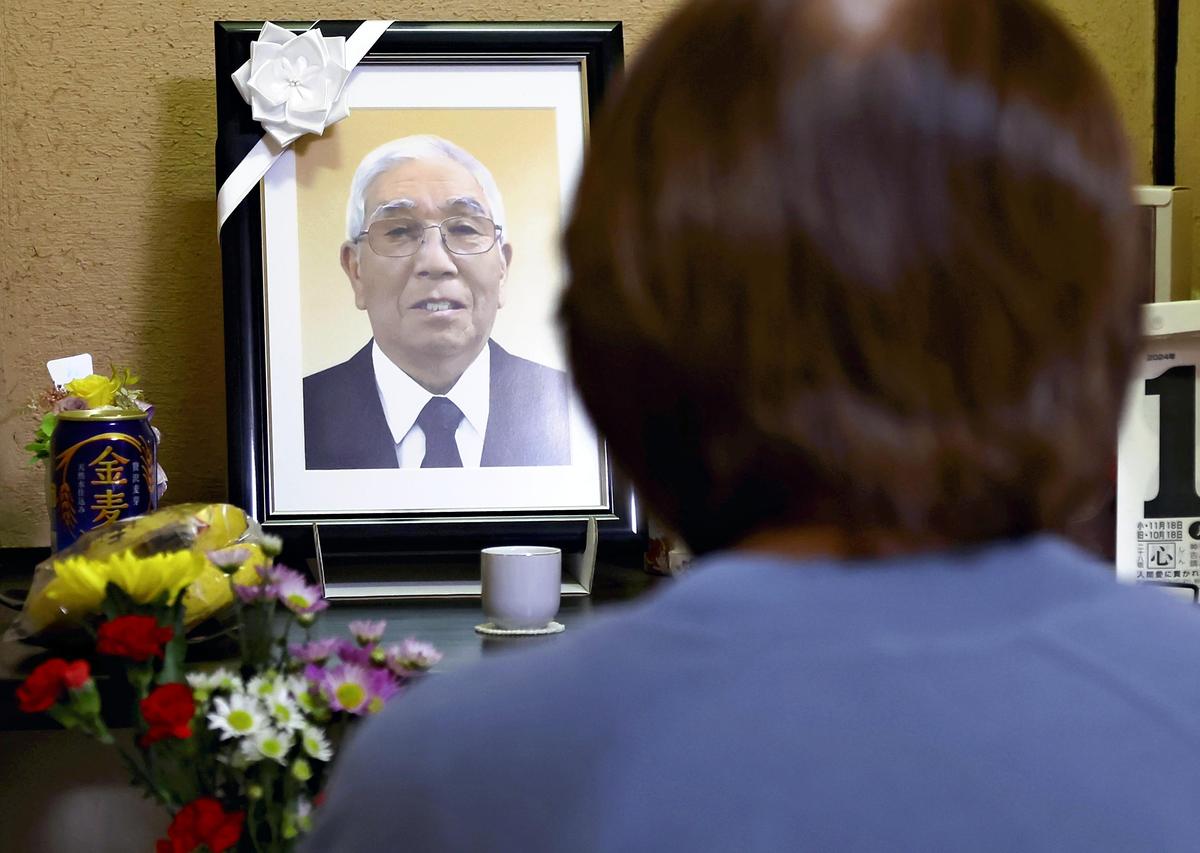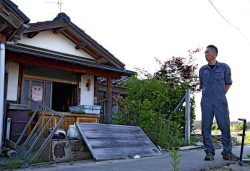Harsh Life as Evacuees Led to Deaths After Noto Quake; ‘Disaster-Related’ Fatalities Outnumber Those from Direct Harm

Hiromi Joka prays in front of a photo of her father, Ryokichi Omote, in Wajima, Ishikawa Prefecture, on Nov. 18.
17:44 JST, December 16, 2024
KANAZAWA — A total of 241 people had been recognized as of Sunday as disaster-related deaths in Ishikawa Prefecture connected to the Noto Peninsula Earthquake, dying of such causes as the worsening of chronic illnesses and the physical and mental stress of the harsh living environment for evacuees.
The figure exceeded 228, the number of deaths caused by collapsed houses and other direct damage from the earthquake.
More than 90% of the 241 people were aged 70 or older.
The prefecture has been working to prevent disaster-related deaths. However, there are over 200 additional people who died after the earthquake and whose families are still waiting for their deaths to be recognized as disaster-related.
Cold corridor
Hiromi Joka, 57, of Wajima in the prefecture, said that although her father Ryokichi Omote survived the Jan. 1 quake, he died two months later after staying in the cold corridor of an evacuation center and elsewhere.
Omote moved from the evacuation center to an apartment in Kanazawa, a secondary evacuation site, in late January, but then stopped taking his daily walks, Joka said. He fell ill in mid-February and died of bacterial pneumonia. He was 84.
According to Joka, her father repeatedly said he wanted to return to Wajima. “Before the earthquake, he was in perfect health. If only I hadn’t made him evacuate,” Joka said in tears in front of his photograph.
Causal relationship
A panel set up by the prefecture and disaster-affected cities and towns determines the causal relationship between the earthquake and deaths, based on materials including death certificates and interviews with the bereaved families. Information on disaster-related death cases compiled by the Cabinet Office is also used as a reference.
If the panel finds a causal relationship, a bereaved family will receive a disaster condolence payment of up to ¥5 million. This is the same amount available to the families of people who died as a result of direct damage from the quake.
The Yomiuri Shimbun analyzed 119 disaster-related deaths whose illness or circumstances of their death had been made public by the affected municipalities, using the Cabinet Office’s compilation of disaster-related death cases as a reference.
It found that 37% of the deaths were due to “physical and mental stress from living in evacuation sites and other places,” followed by 26% caused by “physical and mental stress from the disruption of lifelines such as electricity and water.”
At least 37 of the deceased had developed pneumonia and 17 experienced heart failure.
After the Kumamoto Earthquake in April 2016, a total of 222 people were recognized as cases of disaster-related deaths. Forty percent of these deaths were confirmed as the result of “physical and mental stress from the shock from the earthquake and fear of aftershocks,” as were 15% of the disaster-related deaths after the Noto earthquake.
The percentage of deaths after the Noto quake due to “physical and mental stress from living in evacuation sites and other places” was 30% higher than after the Kumamoto earthquake, while 5.2 times more people died from “the stress from the disruption of lifelines.”
In Ishikawa Prefecture, electricity was cut off up to about 40,000 households, and about 110,000 households had no running water. It took about 2½ months to restore the power supply and about five months to restore the water supply, with the exception of some areas.
Some people died of urinary-tract infections caused by insufficient water intake after their physical strength declined due to cold temperatures and insufficient water supply.
Preventive measures
Ishikawa Prefecture has been working to prevent disaster-related deaths since the quake occurred, as it happened in the middle of winter in areas with a high proportion of elderly residents. The prefecture encouraged people to evacuate to hotels and inns far from the disaster area as secondary evacuation sites, and set up “midway evacuation centers” in Kanazawa and elsewhere where people can stay temporarily, until their secondary evacuation sites are decided.
Prefectural staff also routinely visited people staying at home after the disaster and gave them nutritional advice from a dietician.
Nevertheless, many people died. Of the 155 disaster-related deaths whose ages were made public, 94% aged 70 or over. This is higher than the 87% confirmed after the Great East Japan Earthquake and 78% after the Kumamoto Earthquake.
“Their limited access to electricity and water supply, and a long evacuation period were a great burden for the elderly. It is undeniable that long-distance travel [between their home and evacuation sites] was also hard on them,” said Kansai University Prof. Yoshihiro Okumura, an expert on disaster-related deaths.
On Friday, the Cabinet Office revised its guidelines for local governments regarding the management of evacuation centers, and included measures such as ensuring the availability of portable restroom trailers, providing hot meals and promoting the stockpiling of portable beds.
Improving the environment of evacuation centers has been an issue for years, and it is necessary to take action in line with the guidelines as soon as possible.
Emotional support will also be needed.
So far, two suicides have been certified as disaster-related deaths in Ishikawa Prefecture, and some experts point out that disaster victims suffered psychological harm from the torrential rain that hit the areas in late September amid reconstruction efforts.
The prefecture plans to take measures such as having a psychiatrist stationed in Wajima.
"Society" POPULAR ARTICLE
-

M4.9 Earthquake Hits Tokyo, Neighboring Prefectures
-

M7.5 Earthquake Hits Northern Japan; Tsunami Waves Observed in Hokkaido, Aomori and Iwate Prefectures
-

Israeli Tourists Refused Accommodation at Hotel in Japan’s Nagano Pref., Prompting Protest by Israeli Embassy and Probe by Prefecture
-

Tsukiji Market Urges Tourists to Avoid Visiting in Year-End
-

M5.7 Earthquake Hits Japan’s Kumamoto Pref., Measuring Upper 5 Intensity, No Tsunami Expected
JN ACCESS RANKING
-

Keidanren Chairman Yoshinobu Tsutsui Visits Kashiwazaki-Kariwa Nuclear Power Plant; Inspects New Emergency Safety System
-

Imports of Rare Earths from China Facing Delays, May Be Caused by Deterioration of Japan-China Relations
-

University of Tokyo Professor Discusses Japanese Economic Security in Interview Ahead of Forum
-

Japan Pulls out of Vietnam Nuclear Project, Complicating Hanoi’s Power Plans
-

Govt Aims to Expand NISA Program Lineup, Abolish Age Restriction




















